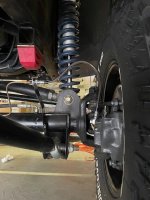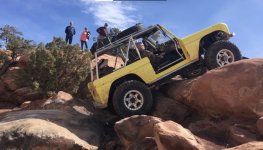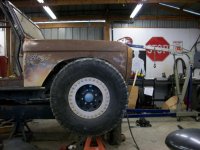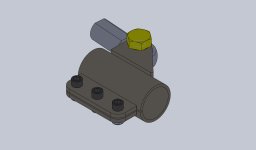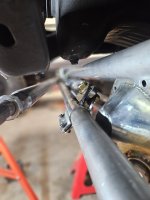I like this idea on getting length by moving the drivers side of track bar out board of the frame but not sure I can get 6.5 inches to match lengths. I do like this approach more than tying into tie rod mid span since it keeps angles lower for both (if I can match lengths and angles)I'm surprised it doesn't drive better than you describe...lots of folks running similar looking geometries without the unsettled handling characteristics through the bumps...and are we talking pot holes or POT HOLES? Could it be a spring rate or damping rate issue with the coilovers? Just from what you describe, I would suggest checking/replacing the track bar bushings on a more stock-ish setup, but everything looks new under there. Adding ram-assist typically slows steering down if anything, but the Ø1.5" bore ram should be the least offensive in that way so long as your pump is up to the task. I'm adding a Ø1.75x8 PSC ram from WH4x4 to mine, and other than the added diameter being a little tougher to package (things are tight to say the least), function should be similar.
I haven't driven mine yet with the new axles and steering, but I have a similar ~41" drag link length with GM TRE's, and in order to get my track bar length and angle to match, I pushed the frame side mount down and out a bit, though less down since I'm not running a dropped pitman arm. The attached image shows the suspension at full stuff (or within about 1/2"), noting that my track bar just clears the front sump on my double-sump oil pan. If mine looks a little different, it's because it's a HP D44 from an F150 at the 65" width, so I have a little more axle tube to play with than you do.
Is the coilover in the way, or could you just replace the frame side track bar mount with one that positions the track bar parallel with the drag link and pushes the mount outward to get closer on the lengths? Matching up the drag link and track bar angles and lengths certainly won't hurt anything, but it may not solve the drivability issue described.
Gonna crawl under truck after work and poke around, will report back.
Maybe not a huge pot hole, but not small ones. And when driving with a concrete barrier on one side (with no shoulder) and 18 wheeler on other side, got me puckered up a bit. And honestly, I *think it should drive better and I enjoy tinkering and love the dialogue from the experts on ways I can make it better.
Based on @ntsqd CAD and eye watering movement at knuckle with much more at wheel diameter, it’s becoming apparent it’s much more than “are they parallel”!











